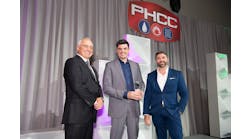FALLS CHURCH, VA. — Dave Yates has provided an informative article in the May issue of Contractor on the changes to the Safe Drinking Water Act (SDWA). The SDWA is a large and encompassing document. The Reduction of Lead in Drinking Water Act represents changes to a very small segment of this act. We would like to point out some areas in the article that should be clarified.
It is stated that the problem lies in the wording of the exceptions created in the law, “if the end use includes, or was intended for… .” The actual wording is “anticipated for,” not “intended for.” This is a big difference as one could see a device as “not intended” for a usage that is ultimately done. If one, however, envisions a usage could happen then it is anticipated. This wording is causing much confusion. In truth, the original SDWA section did not have these exemptions, all products had to comply.
The article states that hose bibs are exempt. The language in the Senate Bill and the Get The Lead Out Plumbing (GTLOP) presentation does not say that. The changes to the SDWA do not mention hose bibs specifically, it is mentioned that devices “…that are used exclusively for non-potable services such as… outdoor watering…” are exempt. By this wording, hose bibs would be exempt if they were exclusively for outdoor watering use. Again, if you anticipate someone would drink from it, the device should be compliant.
Another misconception lies in thinking that all brass must comply with the 0.25% maximum content. In truth, the 0.25% is a weighted average of the wetted surface. On single component products, this is true. When a product is made up of multiple components to form a single finished device, then all of the components are itemized and their individual lead contents are added in the same proportion as their individual components weight to the total weight of the wetted components.
In closing, the industry is awaiting guidance from the EPA to help with the implementation. Some Frequently Asked Questions (and answers) have been released by EPA for the public to review and furnish comments on. The list is available at http://water.epa.gov/drink/info/lead/index.cfm#lfree. It will be later this year before many of the industry concerns are addressed, possibly into next year. In the meantime the industry is trying to raise awareness of the implications of this change for the health and safety of our children and adults.
The Get The Lead Out Plumbing Consortium, a cross section of the plumbing industry comprised of leading trade associations and manufacturers, was founded in 2012. Its mission is to provide widespread education about the manufacture, distribution and installation of Lead Free plumbing products.
Members of the consortium include: American Society of Plumbing Engineers (ASPE); American Supply Association (ASA); International Association of Plumbing and Mechanical Officials (IAPMO); International Code Council (ICC); Legend Valve; Milwaukee Valve; NIBCO INC.; Plumbing Heating Cooling Contractors — National Association (PHCC); PHCC Educational Foundation; Plumbing Manufacturers International (PMI); Reliance Worldwide; Viega LLC and Watts Water Technologies.
Sincerely,
The Get The Lead Out Plumbing Consortium

